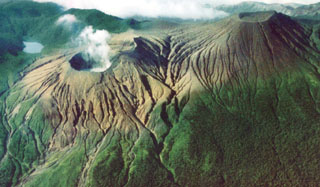Report on Rincon de la Vieja (Costa Rica) — 26 April-2 May 2023
Smithsonian Institution / US Geological Survey
Weekly Volcanic Activity Report, 26 April-2 May 2023
Managing Editor: Sally Sennert.
Please cite this report as:
Global Volcanism Program, 2023. Report on Rincon de la Vieja (Costa Rica) (Sennert, S, ed.). Weekly Volcanic Activity Report, 26 April-2 May 2023. Smithsonian Institution and US Geological Survey.
Rincon de la Vieja
Costa Rica
10.83°N, 85.324°W; summit elev. 1916 m
All times are local (unless otherwise noted)
OVSICORI-UNA reported that phreatic eruptions continued to periodically occur at Rincón de la Vieja during 26 April-1 May. Near-continuous and intense tremor continued along with a few low-frequency, tornillo-type earthquakes and volcanic-tectonic earthquakes. Phreatic events at 0453, 0523, and 0545 on 26 April generated gas-and-steam plumes, and an event at 0528 on 27 April produced a gas-and-steam plume that rose 800 m above the crater rim. Several phreatic events occurred during 27-28 April and generated gas-and-steam emissions that generally rose no higher than 200 m above the crater rim. A small event at 1030 on 30 April produced a gas-and-steam plume that rose 500 m. A gas-and-steam plume from a moderate phreatic eruption at 1306 on 1 May rose 1 km above the crater rim and was seen by residents N of the volcano and in images from webcams located in Sensoria and Gavilan. A small event was recorded later that day at 2032.
Field observations found that the larger eruption on 21 April ejected tephra up to 3 km around the crater, mainly to the N and S. An analysis of ash deposits under a microscope revealed gray and dark metallic, sulfur-rich spheres characteristic of the hydrothermal system as well as juvenile volcanic glass. Ballistics up to 15 cm in diameter were found around the crater.
Geological Summary. Rincón de la Vieja, the largest volcano in NW Costa Rica, is a remote volcanic complex in the Guanacaste Range. The volcano consists of an elongated, arcuate NW-SE-trending ridge constructed within the 15-km-wide early Pleistocene Guachipelín caldera, whose rim is exposed on the south side. Sometimes known as the "Colossus of Guanacaste," it has an estimated volume of 130 km3 and contains at least nine major eruptive centers. Activity has migrated to the SE, where the youngest-looking craters are located. The twin cone of Santa María volcano, the highest peak of the complex, is located at the eastern end of a smaller, 5-km-wide caldera and has a 500-m-wide crater. A Plinian eruption producing the 0.25 km3 Río Blanca tephra about 3,500 years ago was the last major magmatic eruption. All subsequent eruptions, including numerous historical eruptions possibly dating back to the 16th century, have been from the prominent active crater containing a 500-m-wide acid lake located ENE of Von Seebach crater.
Source: Observatorio Vulcanologico y Sismologico de Costa Rica-Universidad Nacional (OVSICORI-UNA)

